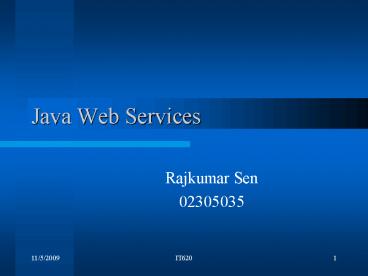Java Web Services - PowerPoint PPT Presentation
1 / 19
Title:
Java Web Services
Description:
Java API for XML-based RPC (JAX-RPC) 10/8/09 ... JAX-RPC API for XML based RPC. RPC-based Web service is a collection of procedures that can be called by a ... – PowerPoint PPT presentation
Number of Views:53
Avg rating:3.0/5.0
Title: Java Web Services
1
Java Web Services
- Rajkumar Sen
- 02305035
2
Outline
- Why Java Web Services
- Java Web Services Developer Pack
- A Simple Web Service scenario
- APIs provided in JWSDP
- Remaining promises
- Conclusion
- References
3
Why Java Web Services
- Ability of enterprises using different computing
platforms to communicate with each other - Java ensures code portability
- J2EE ensures scalability
- APIs hide all the implementation details
- Components are reusable
- Development time is substantially reduced
4
Java Web Service Developer Pack
- Free integrated toolkit that allows Java
developers to build, test and deploy Web services - Web services standards WSDL, SOAP, UDDI
- APIs provided
- Java API for XML Messaging (JAXM)
- Java API for XML Registries (JAXR)
Java API for XML-based RPC (JAX-RPC)
5
Sample Scenario-Online Book store
Book Distributor Web Service
Request prices Order books JAXM/JAX-RPC
Book Store Client
Book Store Server
HTTP
Book Distributor Web Service
JAXR Register Service
JAXR Find service
Registry Server
6
JAX-RPC API for XML based RPC
- RPC-based Web service is a collection of
procedures that can be called by a remote client
e.g.. A stock quote service - Ties, the low-level classes that the server needs
to communicate with a remote client - WSDL document used for creating stubs, the
low-level classes that are needed by a client to
communicate with a remote service. - Stubs can be static or dynamic.
- Tools wscompile and wsdeploy simplify our job
7
JAX-RPC Contd.
- Service consists of
- Interface
- Declares the
service's remote procedures - Implementation class
- Implements the
remote procedures. - Configuration files jaxrpc-ri.xml and
web.xml contain all the parameters needed to
deploy the service. - Client is a Java program which uses the stubs
created from the WSDL document of the service - Configuration file config.xml contains the
location of the WSDL document.
8
JAX-RPC Contd.
- Service Interface
- public interface BookIF
- public Book getPriceList()
- public String orderBook(String BookName,
int quantity) - Implementation class
- public class BookImpl implements BookIF
- public Book getPriceList() . . .
- public String orderBook(String BookName,
int quantity) . . .
9
JAX-RPC Contd.
- Client code
- public class BookClient
- public static void main(String args)
- BookIF BookOrder new
BookServiceImpl().getBookIF() - Book priceList BookOrder.getPriceLi
st() - for (int i 0 i lt priceList.length
i)
10
JAXM API for XML Messaging
- Provides a standard way to send XML documents
over the Internet - Based on SOAP and SOAP with Attachments
specifications - Messaging provider service, which does the
behind-the-scenes work required to transport and
route messages - Standalone client also possible for
request-response type of messaging - Very useful when Enterprise work on shared
schemas.(e.g.. Schema for order form in Online
Book Store)
11
JAXM Contd.
- Advantages over JAX-RPC
- One-way (asynchronous) messaging
- Routing of a message to more than one party
- Reliable messaging with guaranteed delivery
- Steps
- 1.Setting up Connection with the end-point.
- 2.Creating the SOAP message and populate it.
- 3.Sending the message.
12
JAXR API for XML Registries
- Provides a convenient way to
- access standard business registries
- Supports two standards ebXML and UDDI
- Standards groups have developed
- schemas for particular kinds of XML documents,
and two businesses might for example, agree to
use the schema which is stored in the registry.
13
JAXR Contd.
- Querying a registry-Useful methods
- 1.findOrganizations
- which returns a list of organizations
that meet the specified criteria - 2.findServices
- which returns a set of services offered
by a specified organization - 3. findServiceBindings
- which returns the service bindings
(information about how to access the service)
that are supported by a specified service - Similar methods exist for Managing Registry Data.
14
Remaining Promises
- Security provided in JWSDP
- Features yet to be supported in JWSDP
- Simple Implementation of Sample scenarioOnline
book store and try to see the issues/problems
involved. - Issues related to Distributed Transaction
Management.
15
Conclusion
- Role of Java in Web Services
- APIs hide most of the implementation details
- Developer concerned with the logical part of the
Web Service. - However, operability from .NET to J2EE web
services is unclear. No standards defined. - All is not fine
- e.g. Does not support Distributed
Transaction processing
16
References
- 1.The Java Web Services Tutorial
- http//java.sun.com/webservices/docs/1.1/tutorial/
doc/index.html - 2.Java API for XML-RPC web services
- http//java.sun.com/xml/jaxrpc/index.html
- 3.Java API for XML Messaging
- http//java.sun.com/xml/jaxm/index.html
- 4.Java API for XML Registries
- http//java.sun.com/xml/jaxr/index.html
17
- Thank You
18
JAXR Contd.
19
SOAP































